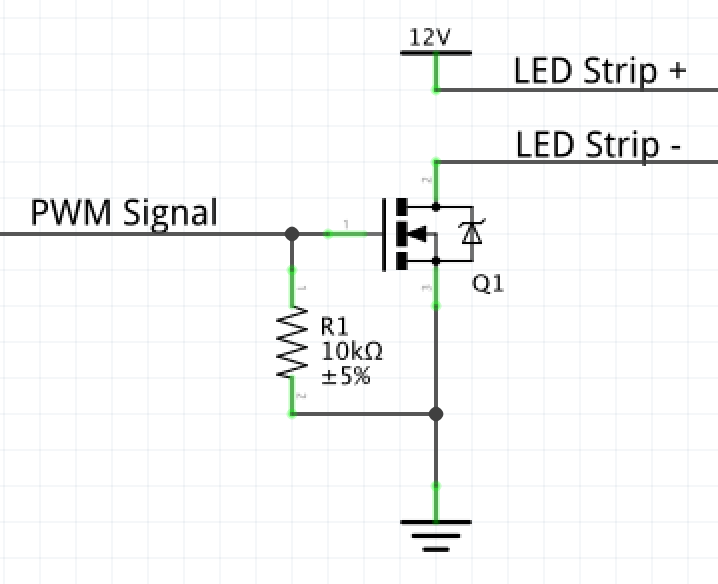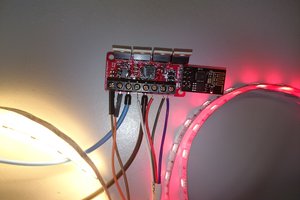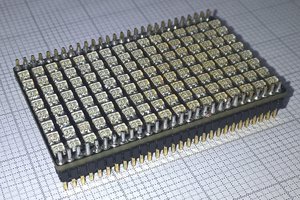Research
I found an excellent blog post by Fred Murphy detailing his work disassembling the UK version of the Hue White bulb that provided a wealth of useful information. While the PCB from his bulb and mine varied a great deal I found that the test points he mapped out appear to be identical to the US version of the bulb based on my initial investigating. I have confirmed that the following do match up.
- TP1 - Ground
- TP25 - Input to voltage regulator
He also found a PWM signal on pin 17 of the micro controller. I was also able to verify this on my version of the bulb. I was also able to traced the PWM signal to R15 which is much easier to solder a wire onto. Keep in mind my bulb is the US version and R15 may not be the same on the UK version.
Circuit Diagram
The PWM signal from the Hue bulb PCB is fed into an N-channel mosfet to drive the LED strip. It is not show in this diagram but the bulbs PCB is also powered from the 12V supply using the test points mentioned above.

Cost Comparison
- Philips Hue LightStrip Plus (6.6 ft) - $89.99
- My DIY Solution - $42.49
- Hue White bulb - $14.99
- Generic LED strip (16.4 ft) - $12
- 12V Power Supply - $12.50
- Other electrical components - about $3
PWM "Flash"
The circuit outlined above is working for me with one exception. When the light is completely off and turned on there is a very brief flash to full brightness before ramping from 0% to the desired brightness. While it is still usable it is very annoying and I have been unable to track down the cause of this flash or how to eliminate it.
The following image shows the "flash" caught on my oscilloscope. It lasts for approximately 13ms.

So far I have made the following observations regarding the issue:
- The "flash" can be observed from R15 where I am tapping into the signal but also directly on pin 17 on the micro controller. It appears to be the signal being put out by the micro controller directly.
- The Hue White bulbs do not exhibit this behavior with their built in LEDs.
- It is only seen when the "bulb" is off (set to off with the app not disconnected from power) and then turned on. It is not witnessed when adjusting the brightness, for example.
I'm going to continue to try and figure out a way to eliminate the flash. As of now I have a few theories as to what might be going on.
- The bulb doesn't turn on the power supply side of things until after the 13ms flash.
- I damaged the micro controller or another component while probing for the PWM signal or in some other way.
I'm going to purchase another bulb to tear apart soon so that I can verify if this is the expected output or if I have done something to cause it.
Disclaimer
I'd just like to state that I am by no means an expert with electronics. This is purely a hobby for me. If you see something incorrect or have any suggestions please let me know.
 Matthew Sheffield
Matthew Sheffield



 Alex
Alex
 parkolay
parkolay